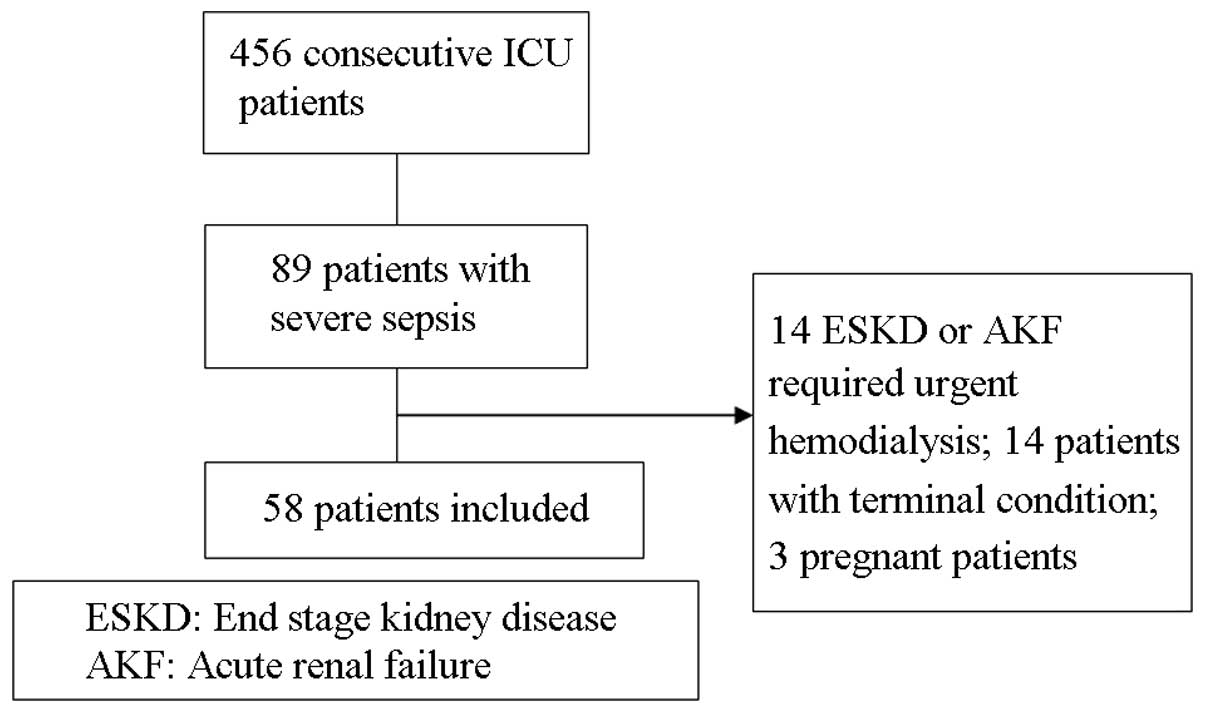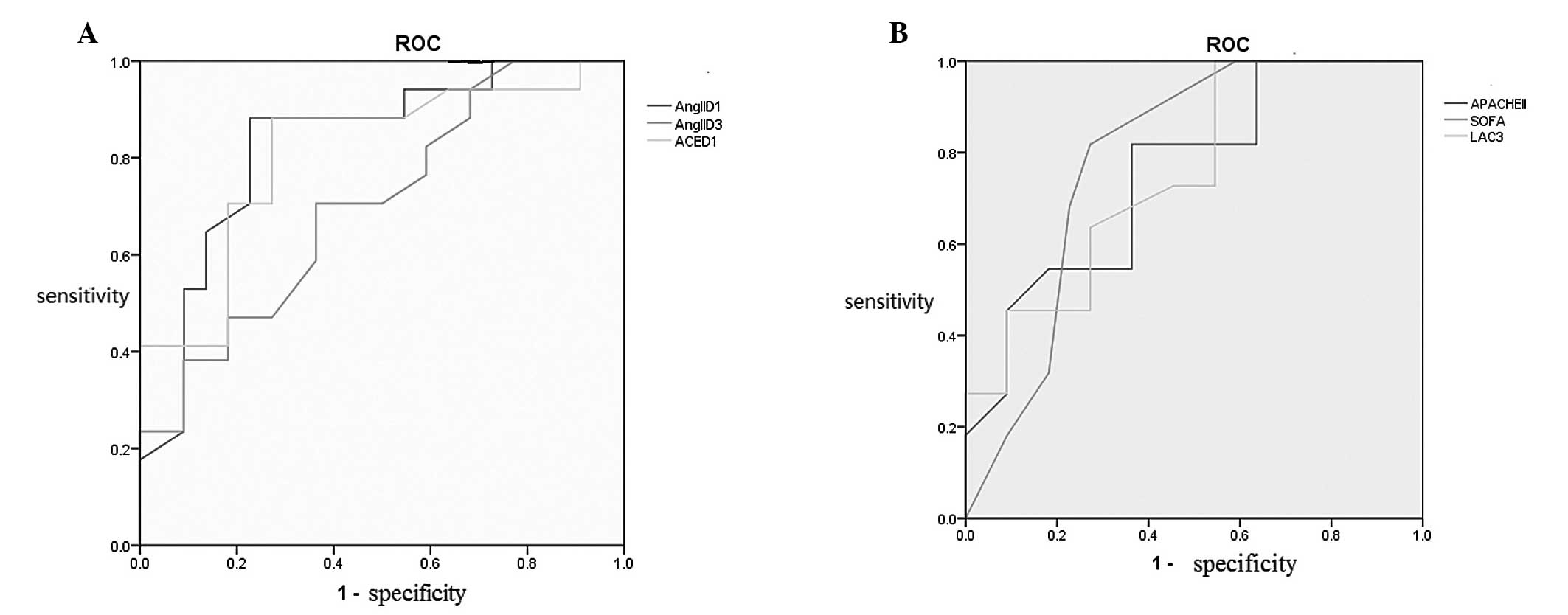|
1
|
Bone RC: A critical evaluation of new
agents for the treatment of sepsis. JAMA. 266:1686–1691. 1991.
View Article : Google Scholar : PubMed/NCBI
|
|
2
|
Hicks P and Cooper DJ; Australian and New
Zealand Intensive Care Society (ANZICS) Board and Clinical Trials
Group Executive Committee. The Surviving Sepsis Campaign:
International guidelines for management of severe sepsis and septic
shock: 2008. Crit Care Resusc. 10:82008.
|
|
3
|
Brun-Buisson C, Doyon F, Carlet J, et al:
Incidence, risk factors, and outcome of severe sepsis and septic
shock in adults. A multicenter prospective study in intensive care
units French ICU Group for Severe Sepsis. JAMA. 274:968–974. 1995.
View Article : Google Scholar : PubMed/NCBI
|
|
4
|
Tamion F, Le Cam-Duchez V, Menard JF,
Girault C, Coquerel A and Bonmarchand G: Erythropoietin and renin
as biological markers in critically ill patients. Crit Care.
8:R328–R335. 2004. View
Article : Google Scholar : PubMed/NCBI
|
|
5
|
Higuchi S, Ohtsu H, Suzuki H, Shirai H,
Frank GD and Eguchi S: Angiotensin II signal transduction through
the AT1 receptor: novel insights into mechanisms and
pathophysiology. Clin Sci (Lond). 112:417–428. 2007. View Article : Google Scholar : PubMed/NCBI
|
|
6
|
Crouser ED: Mitochondrial dysfunction in
septic shock and multiple organ dysfunction syndrome.
Mitochondrion. 4:729–741. 2004. View Article : Google Scholar : PubMed/NCBI
|
|
7
|
Salgado DR, Rocco JR, Silva E and Vincent
JL: Modulation of the renin-angiotensin-aldosterone system in
sepsis: a new therapeutic approach? Expert Opin Ther Targets.
14:11–20. 2010. View Article : Google Scholar : PubMed/NCBI
|
|
8
|
Schmidt C, Höcherl K, Kurt B, Moritz S,
Kurtz A and Bucher M: Blockade of multiple but not single cytokines
abrogates downregulation of angiotensin II type-I receptors and
anticipates septic shock. Cytokine. 49:30–38. 2010. View Article : Google Scholar : PubMed/NCBI
|
|
9
|
Wan L, Langenberg C, Bellomo R and May CN:
Angiotensin II in experimental hyperdynamic sepsis. Crit Care.
13:R1902009. View
Article : Google Scholar : PubMed/NCBI
|
|
10
|
Yunge M and Petros A: Angiotensin for
septic shock unresponsive to noradrenaline. Arch Dis Child.
82:388–389. 2000. View Article : Google Scholar : PubMed/NCBI
|
|
11
|
No authors listed. American College of
Chest Physicians/Society of Critical Care Medicine Consensus
Conference: definitions forsepsis and organ failure and guidelines
for the use of innovative therapies in sepsis. Crit Care Med.
20:864–874. 1992. View Article : Google Scholar
|
|
12
|
Mehta RL, Kellum JA, Shah SV, Molitoris
BA, Ronco C, Warnock DG and Levin A; Acute Kidney Injury Network.
Acute Kidney Injury Network: report of an initiative to improve
outcomes in acute kidney injury. Crit Care. 11:R312007. View Article : Google Scholar : PubMed/NCBI
|
|
13
|
Bernard GR, Artigas A, Brigham KL, et al;
The American-European Consensus Conference of ARDS. Definitions,
mechanisms, relevant outcomes, and clinical trial coordination. Am
J Respir Crit Care Med. 149(3 Pt 1): 818–824. 1994. View Article : Google Scholar : PubMed/NCBI
|
|
14
|
Kreger BE, Craven DE and McCabe WR:
Gram-negative bacteremia. IV Re-evaluation of clinical features and
treatment in 612 patients. Am J Med. 68:344–355. 1980.PubMed/NCBI
|
|
15
|
Bone RC, Fischer CJ Jr, Clemmer TP,
Slotman GJ, Metz CA and Balk RA: Sepsis syndrome: a valid clinical
entity. Methylprednisolone Severe Sepsis Study Group. Crit Care
Med. 17:389–393. 1989. View Article : Google Scholar : PubMed/NCBI
|
|
16
|
Sprung CL, Peduzzi PN, Shatney CH, et al:
Impact of encephalopathy on mortality in the sepsis syndrome. Crit
Care Med. 18:801–806. 1990. View Article : Google Scholar : PubMed/NCBI
|
|
17
|
Calandra T, Baumgartner JD, Grau GE, et
al: Prognostic values of tumor necrosis factor/cachectin,
interleukin-1, interferon-alpha, interferon-gamma in the serum of
patients with septic shock. Swiss-Dutch J5 Immunoglobulin Study
Group. J Infect Dis. 161:982–987. 1990. View Article : Google Scholar
|
|
18
|
Clemmer TP, Fischer CJ Jr, Bone RC,
Slotman GJ, Metz CA and Thomas FO: Hypothermia in the sepsis
syndrome and clinical outcome. The Methylprednisolone Severe Sepsis
Study Group. Crit Care Med. 20:1395–1401. 1992. View Article : Google Scholar : PubMed/NCBI
|
|
19
|
Zabolotskikh IB, Musaeva TS and Denisova
EA: Validity of APACHE II, APACHE III, SAPS 2, SAPS 3 and SOFA
scales in obstetric patients with sepsis. Anesteziol Reanimatol.
Nov–Dec;55–57. 2012.PubMed/NCBI
|
|
20
|
Chen SJ, Chao TF, Chiang MC, Kuo SC, Chen
LY, Yin T, Chen TL and Fung CP: Prediction of patient outcome from
Acinetobacter baumannii bacteremia with Sequential Organ
Failure Assessment (SOFA) and Acute Physiology and Chronic Health
Evaluation (APACHE) II scores. Intern Med. 50:871–877. 2011.
|
|
21
|
Suzuki Y, Ruiz-Ortega M, Lorenzo O,
Ruperez M, Esteban V and Egido J: Inflammation and angiotensin II.
Int J Biochem Cell Biol. 35:881–900. 2003. View Article : Google Scholar
|
|
22
|
Lund DD, Brooks RM, Faraci FM and Heistad
DD: Role of angiotensin II in endothelial dysfunction induced by
lipopolysaccharide in mice. Am J Physiol Heart Circ Physiol.
293:H3726–H3731. 2007. View Article : Google Scholar : PubMed/NCBI
|
|
23
|
Yao S, Feng D, Wu Q, Li K and Wang L:
Losartan attenuates ventilator-induced lung injury. J Surg Res.
145:25–32. 2008. View Article : Google Scholar : PubMed/NCBI
|
|
24
|
Wiel E, Pu Q, Leclerc J, et al: Effects of
the angiotensin-converting enzyme inhibitor perindopril on
endothelial injury and hemostasis in rabbit endotoxic shock.
Intensive Care Med. 30:1652–1659. 2004. View Article : Google Scholar : PubMed/NCBI
|
|
25
|
Hagiwara S, Iwasaka H, Hidaka S, Hasegawa
A, Koga H and Noguchi T: Antagonist of the type-1 ANG II receptor
prevents against LPS-induced septic shock in rats. Intensive Care
Med. 35:1471–1478. 2009. View Article : Google Scholar : PubMed/NCBI
|
|
26
|
Almeida WS, Maciel TT, Di Marco GS,
Casarini DE, Campos AH and Schor N: Escherichia coli
lipopolysaccharide inhibits renin activity in human mesangial
cells. Kidney Int. 69:974–980. 2006. View Article : Google Scholar
|
|
27
|
Bucher M, Hobbhahn J and Kurtz A: Nitric
oxide-dependent down-regulation of angiotensin II type 2 receptors
during experimental sepsis. Crit Care Med. 29:1750–1755. 2001.
View Article : Google Scholar : PubMed/NCBI
|
|
28
|
Dunn CW and Horton JW: Role of angiotensin
II in neonatal sepsis. Circ Shock. 40:144–150. 1993.PubMed/NCBI
|
|
29
|
Graninger M, Marsik C, Dukic T, Wagner OF,
Blann AD and Jilma B: Enalapril does not alter adhesion molecule
levels in human endotoxemia. Shock. 19:448–451. 2003. View Article : Google Scholar : PubMed/NCBI
|
|
30
|
Bexelius TS, Blomberg J, Lu YX, et al:
Losartan to prevent hyperenzymemia after endoscopic retrograde
cholangiopan-creatography: A randomized clinical trial. World J
Gastrointest Endosc. 4:506–512. 2012. View Article : Google Scholar : PubMed/NCBI
|
|
31
|
Dong LW, Chang YZ, Tong LJ, Tang J, Su JY
and Tang CS: Role of regulatory peptide in pathogenesis of shock.
Sci China B. 37:162–169. 1994.PubMed/NCBI
|
|
32
|
Annane D, Sébille V, Troché G, Raphaël JC,
Gajdos P and Bellissant E: A 3-level prognostic classification in
septic shock based on cortisol levels and cortisol response to
corticotropin. JAMA. 283:1038–1045. 2000. View Article : Google Scholar : PubMed/NCBI
|












